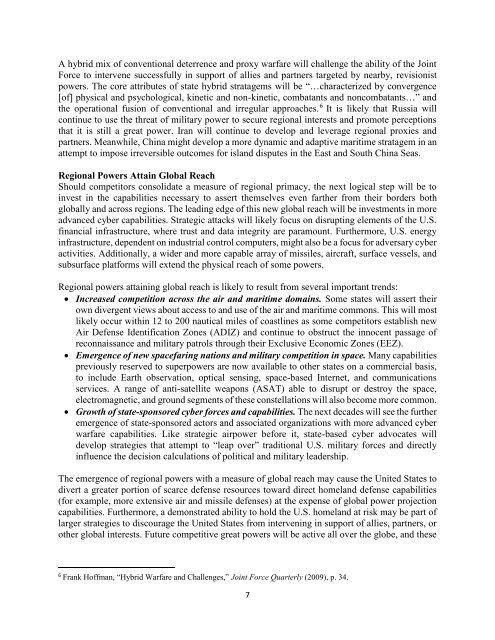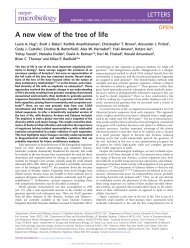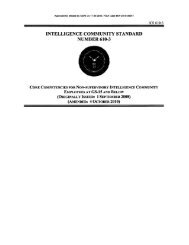The Joint Force in a Contested and Disordered World
JCS-JOE-2035
JCS-JOE-2035
You also want an ePaper? Increase the reach of your titles
YUMPU automatically turns print PDFs into web optimized ePapers that Google loves.
A hybrid mix of conventional deterrence <strong>and</strong> proxy warfare will challenge the ability of the <strong>Jo<strong>in</strong>t</strong><br />
<strong>Force</strong> to <strong>in</strong>tervene successfully <strong>in</strong> support of allies <strong>and</strong> partners targeted by nearby, revisionist<br />
powers. <strong>The</strong> core attributes of state hybrid stratagems will be “…characterized by convergence<br />
[of] physical <strong>and</strong> psychological, k<strong>in</strong>etic <strong>and</strong> non-k<strong>in</strong>etic, combatants <strong>and</strong> noncombatants…” <strong>and</strong><br />
the operational fusion of conventional <strong>and</strong> irregular approaches. 6 It is likely that Russia will<br />
cont<strong>in</strong>ue to use the threat of military power to secure regional <strong>in</strong>terests <strong>and</strong> promote perceptions<br />
that it is still a great power. Iran will cont<strong>in</strong>ue to develop <strong>and</strong> leverage regional proxies <strong>and</strong><br />
partners. Meanwhile, Ch<strong>in</strong>a might develop a more dynamic <strong>and</strong> adaptive maritime stratagem <strong>in</strong> an<br />
attempt to impose irreversible outcomes for isl<strong>and</strong> disputes <strong>in</strong> the East <strong>and</strong> South Ch<strong>in</strong>a Seas.<br />
Regional Powers Atta<strong>in</strong> Global Reach<br />
Should competitors consolidate a measure of regional primacy, the next logical step will be to<br />
<strong>in</strong>vest <strong>in</strong> the capabilities necessary to assert themselves even farther from their borders both<br />
globally <strong>and</strong> across regions. <strong>The</strong> lead<strong>in</strong>g edge of this new global reach will be <strong>in</strong>vestments <strong>in</strong> more<br />
advanced cyber capabilities. Strategic attacks will likely focus on disrupt<strong>in</strong>g elements of the U.S.<br />
f<strong>in</strong>ancial <strong>in</strong>frastructure, where trust <strong>and</strong> data <strong>in</strong>tegrity are paramount. Furthermore, U.S. energy<br />
<strong>in</strong>frastructure, dependent on <strong>in</strong>dustrial control computers, might also be a focus for adversary cyber<br />
activities. Additionally, a wider <strong>and</strong> more capable array of missiles, aircraft, surface vessels, <strong>and</strong><br />
subsurface platforms will extend the physical reach of some powers.<br />
Regional powers atta<strong>in</strong><strong>in</strong>g global reach is likely to result from several important trends:<br />
Increased competition across the air <strong>and</strong> maritime doma<strong>in</strong>s. Some states will assert their<br />
own divergent views about access to <strong>and</strong> use of the air <strong>and</strong> maritime commons. This will most<br />
likely occur with<strong>in</strong> 12 to 200 nautical miles of coastl<strong>in</strong>es as some competitors establish new<br />
Air Defense Identification Zones (ADIZ) <strong>and</strong> cont<strong>in</strong>ue to obstruct the <strong>in</strong>nocent passage of<br />
reconnaissance <strong>and</strong> military patrols through their Exclusive Economic Zones (EEZ).<br />
Emergence of new spacefar<strong>in</strong>g nations <strong>and</strong> military competition <strong>in</strong> space. Many capabilities<br />
previously reserved to superpowers are now available to other states on a commercial basis,<br />
to <strong>in</strong>clude Earth observation, optical sens<strong>in</strong>g, space-based Internet, <strong>and</strong> communications<br />
services. A range of anti-satellite weapons (ASAT) able to disrupt or destroy the space,<br />
electromagnetic, <strong>and</strong> ground segments of these constellations will also become more common.<br />
Growth of state-sponsored cyber forces <strong>and</strong> capabilities. <strong>The</strong> next decades will see the further<br />
emergence of state-sponsored actors <strong>and</strong> associated organizations with more advanced cyber<br />
warfare capabilities. Like strategic airpower before it, state-based cyber advocates will<br />
develop strategies that attempt to “leap over” traditional U.S. military forces <strong>and</strong> directly<br />
<strong>in</strong>fluence the decision calculations of political <strong>and</strong> military leadership.<br />
<strong>The</strong> emergence of regional powers with a measure of global reach may cause the United States to<br />
divert a greater portion of scarce defense resources toward direct homel<strong>and</strong> defense capabilities<br />
(for example, more extensive air <strong>and</strong> missile defenses) at the expense of global power projection<br />
capabilities. Furthermore, a demonstrated ability to hold the U.S. homel<strong>and</strong> at risk may be part of<br />
larger strategies to discourage the United States from <strong>in</strong>terven<strong>in</strong>g <strong>in</strong> support of allies, partners, or<br />
other global <strong>in</strong>terests. Future competitive great powers will be active all over the globe, <strong>and</strong> these<br />
6<br />
Frank Hoffman, “Hybrid Warfare <strong>and</strong> Challenges,” <strong>Jo<strong>in</strong>t</strong> <strong>Force</strong> Quarterly (2009), p. 34.<br />
7











